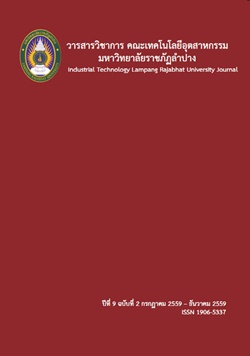14. การวิเคราะห์และการลดต้นทุนโลจิสติกส์ผลิตภัณฑ์เหล็กน้ำพี้
Keywords:
ต้นทุน, โลจิสติกส์, เหล็กน้ำพี้, การย่อยแร่, การถลุงแร่เหล็กน้ำพี้, Costs, Logistics, Nam Phi steel, Grinding, Nam Phi Steel MiningAbstract
การวิจัยนี้ ได้ทำการศึกษาด้านต้นทุน โลจิสติกส์ต้นน้ำ กลางน้ำ และปลายน้ำ ของผลิตภัณฑ์ดาบ พระขรรค์ และมีดเหล็กน้ำพี้ โดยใช้การคำนวณต้นทุนกิจกรรมแบบ Activity - Based Costing (ABC) โดยใช้เครื่องมือจากแบบสอบถามจากกลุ่มเป้าหมายโดยเลือกแบบเจาะจง พบว่า ต้นทุนโลจิสติกส์ต้นน้ำ มีต้นทุนการขุดแร่เหล็กน้ำพี้ ต้นทุนการย่อยแร่ คิดเป็นต้นทุนรวมมีค่าร้อยละ 2.84 ต้นทุนโลจิสติกส์กลางน้ำ มีต้นทุนการถลุงเหล็กน้ำพี้เป็นแท่ง (Ingot) ต้นทุนการผลิตผลิตภัณฑ์ดาบ พระขรรค์ และมีดเหล็กน้ำพี้ คิดเป็นต้นทุนรวมมีค่าร้อยละ 31.71 ต้นทุนโลจิสติกส์ปลายน้ำ พบว่า ในปัจจุบันมีการจำหน่ายในพื้นที่คิดเป็นร้อยละ 70 การจำหน่ายนอกพื้นที่จังหวัด คิดเป็นร้อยละ 24 และการจำหน่ายประเภทอื่น ๆ คิดเป็นร้อยละ 6 มีต้นทุนโลจิสติกส์รวมมีค่า ร้อยละ 65.45 จากข้อมูลการศึกษาพบว่า ต้นทุนโลจิสติกส์ที่มีต้นทุนที่สูง คือ ต้นทุนโลจิสติกส์ปลายน้ำ ซึ่งมีต้นทุนค่าการตลาด ค่าขนส่งเพื่อนำผลิตภัณฑ์ดาบ พระขรรค์ และมีดเหล็กน้ำพี้ จำหน่ายให้กับลูกค้า การศึกษายังนำข้อมูลจากการศึกษาถ่ายทอดความรู้ให้กับกลุ่มผลิตผลิตภัณฑ์ในพื้นที่เพื่อเป็นแนวทางในการลดต้นทุนในด้านต่าง ๆ การศึกษาจึงเป็นไปตามวัตถุประสงค์ของการวิจัยในการศึกษาต้นทุนโลจิสติกส์ของการผลิตผลิตภัณฑ์เหล็กน้ำพี้ ซึ่งจะเป็นข้อมูลในการที่จะนำพัฒนาผลิตภัณฑ์ให้มีต้นทุนที่ต่ำ และการวางแผนการตลาดได้อย่างเหมาะสม และเกิดประโยชน์กับชุมชนในการที่จะนำข้อมูลไปใช้ในการขยายตลาดสู่ AEC ต่อไป ในอนาคต
Analysis and Reduction of Logistics Costs of Nam Phi Steel Products
This research studies through Activity-Based Costing (ABC) the upstream, midstream, and downstream logistics costs of Nam Phi steel swords and knives. Questionnaires were used to collect data from the target group, selected by purposive sampling. The results show that upstream logistics costs consisted of the costs of mining and grinding steel and accounted for 2.84% of the total cost. The midstream logistics costs consisted of ingot and production costs, which were 31.71% of the total cost. With regard to downstream costs, it was found that 70% of Nam Phi steel products were distributed in the province, 24% were distributed outside the province and 6% were distributed in other ways. These costs came to 65.45% of the total. It was found that downstream logistics costs were high due to the expense of marketing and of transportation of the products to the customers. The data and knowledge obtained from this research were passed to local community manufacturers to be used as guidelines for reducing costs and making appropriate marketing plans which could be used to expand the product market to the AEC in the future.






